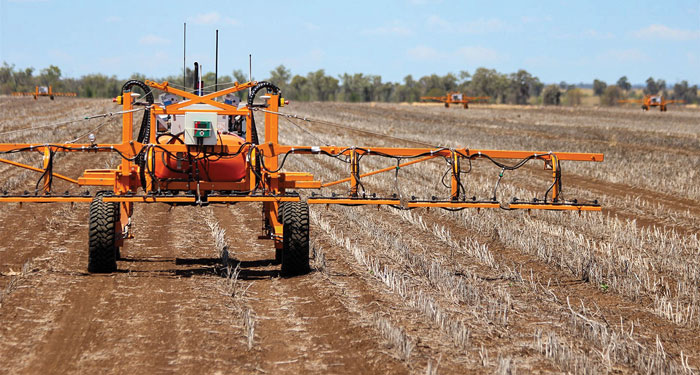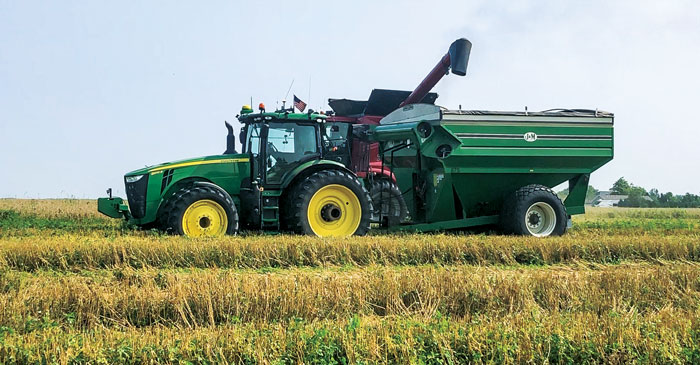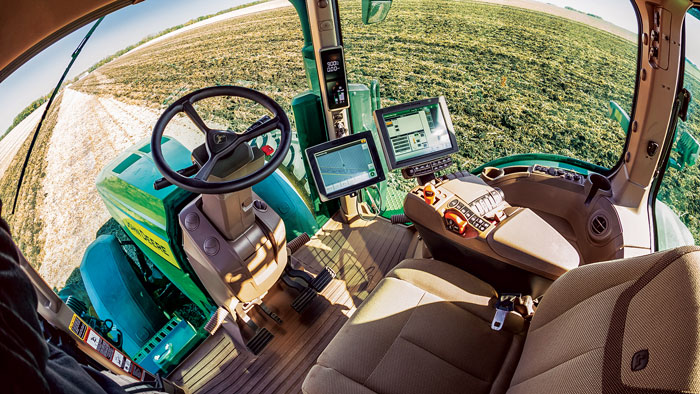A shift to autonomous agriculture puts dealers and farmers in the position to future-proof their business models.
With the rapid evolution of technology, farmers may not be able to afford to continue to control all aspects of their operations. Autonomous farm machinery could lead to producers outsourcing tasks to a skilled equipment operator, allowing the farmer to focus on other parts of their operation.
“There are going to be tremendous business opportunities, especially for dealers,” says Scott Shearer, chair of the department of food, agricultural and biological engineering at Ohio State University.
Not all dealerships will be equipped to take advantage of these opportunities, especially if they’re not already thinking about how they’ll sell autonomy. Mike Houghtaling, owner of technology consulting company P&C Ag Solutions in Reese, Mich., says positioning a dealership for success with autonomy starts with a clearly defined mission and vision.
Dealer Takeaways
- A shift to autonomous equipment will result in more farming-as-a-service operations. As producers outsource tasks, dealers will have new business opportunities.
- Demoing autonomous machinery is key to selling it. Demos require the right technology and partnerships to be successful.
- In autonomy’s infancy, farmers who want autonomous equipment need to be able to adapt their practices to the machine’s current capabilities.
- Dealers who want to sell autonomy need to be prepared for failure and ready to recover from missteps.
“You’re going to build a strategy to achieve that vision,” Houghtaling says. “You’re going to get employees engaged, create partnerships with companies that are developing the products you want to sell, prove their reliability, demo the systems and sell the systems.”
The Autonomy Landscape
Shearer believes autonomy isn’t a passing fad because the major lines are already transitioning from iron companies to technology companies. He points to the slew of startups the majors have acquired and invested in over the last several years.
Shearer says many of these companies — and more than 900 others in the U.S. — are working on developing artificial intelligence to make machines mimic the human brain. In agriculture, this type of technology is already becoming a substitute for chemistry. John Deere’s See & Spray, Precision Planting’s Vision cameras and Symphony nozzle control system, and Greeneye Technology’s sprayer use AI to identify weeds and target spot spray. Deere reports herbicide reductions of 70-90% with its targeted spraying.
The applications for AI don’t end with herbicides either.
“Those cameras and neural network classifiers can be easily reconfigured for almost any job,” Shearer says. “All of our inputs are going to be applied sparingly for exactly what response we want from that crop, depending on weather conditions and a lot of other things. This is where we’re headed.”

SwarmFarm Robotics in Australia leases autonomous sprayers to customers. The $60,000 price includes use of the machine and technical support from SwarmFarm. Shearer says farming as a service is the future of the agriculture industry. Photo Courtesy of SwarmFarm Robotics
Shearer says new business opportunities will appear as more of this technology comes to market, especially with the rise of farming as a service.
Farming as a Service
Farming as a service, a model in which companies provide autonomous equipment to farmers for a fee, is an important trend for dealers to know. Shearer says SwarmFarm Robotics in Australia and Sabanto Ag in the U.S. are both already offering farming as a service.
SwarmFarm leases autonomous sprayers for approximately $60,000 per year, which includes the cost of a technician to set up the machine and provide technical support. Shearer determined the cost of application, without chemical or fuel, would total about $1 per acre. Compared to the $7-10 per acre custom application rates today, renting autonomous equipment would provide huge savings for farmers.
Sabanto Ag uses a fleet of Kubota M5 tractors, which are in the 80-110 horsepower range, to autonomously plant crops.
Sabanto founder Craig Rupp says the company’s machinery costs are down to 7 cents per horsepower hour, compared to 25 cents per horsepower hour for machinery costs in a traditional planting operation.
Shearer says a group of Ohio State students took the concept of farming as a service a step further to a pay-for-performance model. In this scenario, the service provider would seed the field, for example, during a 2-week window specified by the farmer. The provider and the farmer would agree upon a price per acre if the planting resulted in a 98% stand.
“What’s that worth per acre?” Shearer asks. “We’re stuck in a mode today where farmers want bigger equipment to be more timely. Think about the importance of being timely and hitting that planting window.”
Preparing Your Dealership for Autonomy

Looking for additional tips to prepare your dealership for autonomy and more insights about the future of autonomous farm machinery? Click here to access video replays of Scott Shearer’s presentation and the autonomy-focused dealer panel from the 2022 Precision Farming Dealer Summit, brought to you by Laforge.
Selling Autonomy as a Service
In autonomy’s infancy, dealerships have an opportunity to create the infrastructure to sell autonomy as a service. Todd Peterson, owner of Peterson Ag Service in Remington, Ind., is thinking about how autonomy can create recurring revenue for his dealership.
“Whether it be rentals, support or keeping a swarm-type system going, there’s a lot of opportunities out there,” Peterson says. “It’s a matter of preparing ourselves so we’re ready for it.”
P&C Ag plans to sell autonomy as a service. Some options Houghtaling is considering include renting and selling equipment, 3-year lease agreements and subsidizing growers to run the technology in an effort to standardize autonomy. He’s working backward from his end goal of selling autonomy as a service to develop the details of the company’s sales strategy.
In P&C’s first forays into autonomy, things have “gotten messy,” Houghtaling says. Employees have had to install equipment, remove it and then install it again. In those times, Houghtaling says it’s extremely important to make sure those employees are committed to the company’s vision and mission.
“The selling process of autonomy is seeing and believing it…” – Bryan Fehr, Manager, Jenner Precision
“Employees are going to be doing things that weren’t in their job descriptions,” Houghtaling says. “This is going to be way different than anything we’ve sold in the past. This is going to completely transform our business.”
Bryan Fehr, manager of Jenner Precision in Fairbury, Ill. (Precision Farming Dealer’s 2022 Most Valuable Dealership), has also made some changes to staff responsibilities to accommodate autonomy. Jenner Precision sold a Raven OMNiDRIVE autonomous grain cart to a customer in western Illinois last year.
Fehr says he’ll have one employee focused on autonomy this fall to learn the ins and outs of the system and support customers. He plans to add more people devoted solely to autonomy as Jenner Precision sells more autonomous machines.
Demoing Autonomy
These three dealers agree that selling autonomous farm machinery hinges on demoing it. Peterson has been involved with OMNiDRIVE since Smart Ag first introduced the AutoCart project, the original creator and name for the autonomous grain cart technology.
“Autonomy is the next Autopilot,” Peterson says. “When Autopilot first came out, once you saw the wow factor, it was not hard to sell.”
Jenner Precision hosted a field day last summer to show farmers OMNiDRIVE at work. The biggest challenge was finding the right farmer to do the demo, Fehr says. Fall would be too busy, and many of the local organic farmers didn’t have equipment new enough to run OMNiDRIVE. Fehr ended up finding an organic farmer with oat ground and another farmer who let Jenner Precision use his John Deere 8R series tractor for the demo.

A farmer combines oats near Fairbury, Ill., with the help of Raven Industries’ OMNiPOWER, technology that allows a driverless tractor pulling a grain cart to sync up with the combine, during Jenner Precision’s field day in July. Dealers say selling autonomous equipment isn’t difficult after customers see it in action.
“It worked out great because the organic guys usually use their oats for seed,” Fehr says. “He was willing to leave me 3 passes on the north side of the property and 3 passes on the south side of the property. We could do a live demo in the morning and a live demo in the afternoon.”
Fehr let the farmer run OMNiDRIVE for a day prior to the demonstration to get used to it, and then the farmer combined oats with the autonomous grain cart beside him at the field day. During the demo, Jenner Precision set up a camera to livestream what was happening in the machine so people understood that it was operating autonomously.
“We wanted to demo it at 15 mph because that is the wow factor,” Fehr says. “The wow factor is when they can actually see it run. The selling process is seeing and believing it.”
The field day wasn’t flawless — the tractor abruptly stopped in the morning because of a swarm of gnats — but a farmer attending the event told Fehr that he was glad to see hiccups during the demo.
“He said, ‘I’m glad it’s not flawless because that’s what I would expect this fall on my piece of equipment,’” Fehr recalls. “There’s going to be some learning.”
Increased Capital, Technology Needed
A dealership’s capital requirements are going to greatly increase when selling autonomous equipment, according to Houghtaling. P&C bought an 8R tractor to do its own OMNiDRIVE demo.
“If we’re reselling million-dollar robots, we’re going to have to transform our business in order to make that work,” Houghtaling says.
Liability is another big — and potentially costly — consideration for dealers hosting an autonomous equipment demonstration. Peterson and Fehr both roped off an area with caution tape during their autonomy demos, but Peterson warns that dealers need to be aware that mistakes will happen.
“We have to make sure that we can protect ourselves and our customers the best way we know how,” Peterson says.

The cab of John Deere’s autonomous 8R tractor is empty as the machine tills a field. Scott Shearer says Deere and the other major lines are transitioning from iron companies to technology companies.
Dealerships will have varying needs when demoing different types of technology, be it finding cooperatives willing to partner on the field day, a certain tractor to run the equipment or a semi to move equipment to the field day location.
Dealers should also consider what combinations of equipment potential customers will be using to run the autonomous technology. Fehr made a point to secure equipment of different colors for his field day. The Case IH combine using Ag Leader steering synced up with the Deere 8R tractor using Deere’s RTK.
“When I was at training, they told me that it would work with any system as long as they’re both RTK,” Fehr says. “I wanted to prove that we are colorblind and will work with anything in the future. That went very well for us.”
Not every dealership will be able to swallow the cost of selling autonomy, Houghtaling says. It’s not for every dealer or customer.
“We’re not going to be selling a product that’s universally accepted by everybody,” Houghtaling says.
Finding the Right Customers
In the first stages of autonomy, dealers need to make sure that the customer can adapt their practices to the capabilities of the autonomous equipment.
The farmer who agreed to Jenner Precision’s field day thought the autonomous grain cart was for big farmers, not his small organic operation. But once he and his son were on their own operating the equipment after the field day ended, the value of autonomy became apparent.
“During the day, it never connected with him because our service techs loaded the grain truck,” Fehr says, “but when he came back at night, he realized they could do three things with two guys. He doesn’t have a system yet because he doesn’t have the right tractor, but as soon as he gets the right tractor and we get OMNiDRIVE working better, he is 100% on board.”
Peterson Ag Services beta-tested three autonomous systems in fall 2021 and also discovered OMNiDRIVE, as it was then, wasn’t useful to a larger operator because it couldn’t handle multiple machines. Peterson says the right customer at this time is a smaller operation led by a farmer who’s willing to learn.
“Every grower we had demo that system this fall, we had to help train them on how they can utilize the system to benefit their operation, when to call it and when to think for it because it cannot think for itself,” Peterson says.
Peterson’s early adopter customers are ready to pay for autonomous machinery, even though it’s still in the testing phase. He says labor shortages are driving adoption as much as anything else.
Find the Right Partners
Choosing the right technology companies to partner with is critical for success when demoing and selling autonomous equipment.
“As an independent dealer, we need to work with multiple vendors to be able to provide the solutions that the customers need,” Peterson says.
Peterson recalls a time when he had a different drone company in his office every week, all wanting to be vendors. Only a few of those companies survived in the years that followed.
Houghtaling says he looks for companies that have the same goals as P&C Ag. Those companies should also have a long-term vision, good financing and a product that will fit the needs of P&C Ag’s customers.
“The product needs to actually work and be priced correctly,” Houghtaling says. “The grower needs to be able to buy it and have it provide ROI on his farm, and we’ve got to make sure the manufacturer is making money to reinvest to develop more new products.”
Having an aligned partner makes a difference when demoing autonomous farm machinery, too. Jenner Precision’s field day required months of preparation and promotion. Jenner’s staff met with Raven’s marketing team to set up a planning schedule that included months of weekly Zoom meetings.
“Raven did a fantastic job working with our marketing team to advertise the field day,” Fehr says. “We had people from four states show up to see the system.”
Be Ready to Fail
Dealers who are serious about autonomy can’t afford to err on the side of caution.
The dealership may partner with a company that fails or goes through countless acquisitions. A product that’s close to market may never materialize. Technology passed over by the dealership may become a missed opportunity. Dealers must balance those risks with the potential loss of customers and poor market positioning in the future.
“You have to have the ability to fail without giving up,” Houghtaling says. “It’s a lot of mental strain to fail, and it wears on you after a while.”
With a commitment to a strong mission and vision, the dealership will come out ahead in the long haul.
“We’ve got to be willing to fail and be dedicated to what we’re doing,” Peterson says. “Autonomy is here, and it is going to be a very important part of the dealership as we move forward.”
Are We Entering Precision Farming Sales & Service 2.0?
3 Precision Managers Share Their Keys to Success
How to Prepare Your Dealership for Autonomy
Turning Data Into Efficiency to Boost Your Precision Business
Master Precision Management at Your Dealership
Shared Values & Vision are Vital to Maintaining Employee Engagement








Post a comment
Report Abusive Comment